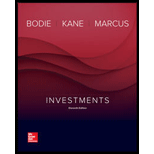
Investments
11th Edition
ISBN: 9781259277177
Author: Zvi Bodie Professor, Alex Kane, Alan J. Marcus Professor
Publisher: McGraw-Hill Education
expand_more
expand_more
format_list_bulleted
Concept explainers
Question
Chapter 23, Problem 4CP
Summary Introduction
To calculate: Holding period return of the U.S dollar that is recommended by Hamson and also determine whether the U.S. dollar holding-period return resulting from the transaction in U.S. or not.
Introduction: The holding period of U.S dollar is calculated by the rate parity equation. This equation says that holding period must be null.
Expert Solution & Answer
Want to see the full answer?
Check out a sample textbook solution
Students have asked these similar questions
Which of the following is considered a long-term financing source for a company?A) Accounts PayableB) Common StockC) Short-term loansD) Accrued Expenses
Which of the following best defines the term "capital structure"?A) The way a company raises its capital through debt and equityB) The investment decisions made by a companyC) The amount of profit a company generatesD) The distribution of earnings to shareholdersneed help
Which of the following is considered a long-term financing source for a company?A) Accounts PayableB) Common StockC) Short-term loansD) Accrued Expenses
Chapter 23 Solutions
Investments
Ch. 23 - Prob. 1PSCh. 23 - Prob. 2PSCh. 23 - Prob. 3PSCh. 23 - Prob. 4PSCh. 23 - Prob. 5PSCh. 23 - Prob. 6PSCh. 23 - Prob. 7PSCh. 23 - Prob. 8PSCh. 23 - Prob. 9PSCh. 23 - Prob. 10PS
Ch. 23 - Prob. 11PSCh. 23 - Prob. 12PSCh. 23 - Prob. 13PSCh. 23 - Prob. 14PSCh. 23 - Prob. 15PSCh. 23 - Prob. 16PSCh. 23 - Prob. 17PSCh. 23 - Prob. 18PSCh. 23 - Prob. 19PSCh. 23 - Prob. 20PSCh. 23 - Prob. 21PSCh. 23 - Prob. 22PSCh. 23 - Prob. 23PSCh. 23 - Prob. 24PSCh. 23 - Prob. 25PSCh. 23 - Prob. 26PSCh. 23 - Prob. 1CPCh. 23 - Prob. 2CPCh. 23 - Prob. 3CPCh. 23 - Prob. 4CPCh. 23 - Prob. 5CPCh. 23 - Prob. 6CPCh. 23 - Prob. 7CPCh. 23 - Prob. 8CP
Knowledge Booster
Learn more about
Need a deep-dive on the concept behind this application? Look no further. Learn more about this topic, finance and related others by exploring similar questions and additional content below.Similar questions
- Which of the following best defines the term "capital structure"?A) The way a company raises its capital through debt and equityB) The investment decisions made by a companyC) The amount of profit a company generatesD) The distribution of earnings to shareholdershelparrow_forwardWhich of the following best defines the term "capital structure"?A) The way a company raises its capital through debt and equityB) The investment decisions made by a companyC) The amount of profit a company generatesD) The distribution of earnings to shareholdersarrow_forwardThe time value of money concept is based on the idea that: A) Money loses value over timeB) Money has the same value over timeC) The value of money increases over time due to inflationD) A dollar today is worth more than a dollar in the futurehelparrow_forward
- The time value of money concept is based on the idea that: A) Money loses value over timeB) Money has the same value over timeC) The value of money increases over time due to inflationD) A dollar today is worth more than a dollar in the future explain.arrow_forwardThe time value of money concept is based on the idea that: A) Money loses value over timeB) Money has the same value over timeC) The value of money increases over time due to inflationD) A dollar today is worth more than a dollar in the futurearrow_forwardWhich of the following is the most appropriate metric for determining a company's profitability?A) Return on Assets (ROA)B) Debt-to-Equity RatioC) Price-to-Earnings (P/E) RatioD) Current Ratio need helparrow_forward
- Which of the following is the most appropriate metric for determining a company's profitability?A) Return on Assets (ROA)B) Debt-to-Equity RatioC) Price-to-Earnings (P/E) RatioD) Current Ratio explain.arrow_forwardWhich of the following is the most appropriate metric for determining a company's profitability?A) Return on Assets (ROA)B) Debt-to-Equity RatioC) Price-to-Earnings (P/E) RatioD) Current Ratioarrow_forwardWhat does the term "liquidity" refer to in financial management?A) The profitability of a companyB) The ease with which an asset can be converted into cashC) The long-term sustainability of a companyD) The company's capital structure helparrow_forward
- What does the term "liquidity" refer to in financial management?A) The profitability of a companyB) The ease with which an asset can be converted into cashC) The long-term sustainability of a companyD) The company's capital structurearrow_forwardWhich of the following is a method for valuing a stock using expected future dividends?A) Net Present Value (NPV)B) Dividend Discount Model (DDM)C) Price-to-Earnings (P/E) RatioD) Internal Rate of Return (IRR) explain.arrow_forwardWhich of the following is a method for valuing a stock using expected future dividends?A) Net Present Value (NPV)B) Dividend Discount Model (DDM)C) Price-to-Earnings (P/E) RatioD) Internal Rate of Return (IRR)arrow_forward
arrow_back_ios
SEE MORE QUESTIONS
arrow_forward_ios
Recommended textbooks for you

Foreign Exchange Risks; Author: Kaplan UK;https://www.youtube.com/watch?v=ne1dYl3WifM;License: Standard Youtube License